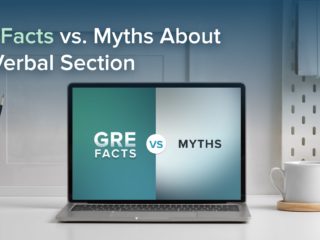| Getting your Trinity Audio player ready... |
Last Updated on November 14, 2023
If you are new to the GRE, you may wonder about the structure of GRE math. While we have some details in our blog about the format of the GRE, we will provide some additional detail here. This article discusses the GRE Math section breakdown, and the frequency and types of questions that you can expect to see on your exam.
Here are the topics we’ll cover:
- The Three Parts of the GRE
- What GRE Quant Topics Might You See on the GRE?
- Don’t Forget About the Many Math Subtopics
- The Math Topics You’ll Encounter on the GRE Are Quite Unpredictable
- How to Prepare for the GRE Math Section
- The Four Types of GRE Math Questions
- GRE Math Summary
- Frequently Asked Questions (FAQ)
- What’s Next?
Let’s first discuss the general format of the Quant section of the GRE.
The Three Parts of the GRE Quantitative reasoning section
There are two parts on the GRE besides the Quantitative Reasoning section: the Verbal Reasoning section and the Analytical Writing section. However, generally, graduate programs are most concerned with your Verbal and Quant scores.
TTP PRO TIP:
The Verbal and Quantitative sections are generally the most important parts of the GRE.
There are a total of 27 math questions, broken into two sections: the first section contains 12 questions, and the second section contains 15 questions.
Next, let’s discuss what topics you can see in the Quant sections of the GRE.
What GRE Quant Topics Might You See on the GRE?
If you have researched GRE Quant, you likely know that the GRE tests “high school math.” So naturally, most folks studying for the GRE will eventually lean on their high school math chops during their preparation.
KEY FACT:
The GRE Quant section covers many high school-level math concepts.
Below are the matht topics that can show up on your GRE:
- Basic Arithmetic
- Linear and Quadratic Equations
- Number Properties
- Roots
- Exponents
- Inequalities
- Absolute Values
- General Word Problems
- Rates
- Work Problems
- Unit Conversions
- Ratios
- Percents
- Statistics
- Overlapping Sets
- Combinations and Permutations
- Probability
- Geometry
- Coordinate Geometry
- Sequences
- Functions
- Data Analysis
- Data Interpretation Questions
KEY FACT:
21 major math topics are on the GRE.
Next, we will discuss GRE math subtopics.
Don’t Forget About the Many Math Subtopics
Twenty-one major Quant topics may not seem like a lot. However, you can’t forget the hundreds of subtopics that can also show up.
For example, let’s consider the math topic of Geometry. Sure, you must have a basic understanding of the shapes tested in GRE Geometry questions. However, there are so many subtopics you need to know to be successful with Geometry questions. For example, you’ll need to know about subtopics such as the sum of interior or exterior angles, ratios of 30-60-90 right triangles, inscribed shapes, arc lengths, etc. Therefore, you should be prepared to handle the hundreds of subtopics that could appear in the GRE Quant section.
TTP PRO TIP:
The GRE Quant section contains hundreds of subtopics, despite covering only 21 main Quant topics.
Let’s next discuss the unpredictability of GRE math.
The Math Topics You’ll Encounter on the GRE Are Quite Unpredictable
The math topics you see on test day are quite unpredictable. In other words, you never know what you will get and from what topic. Furthermore, if you take the GRE multiple times, do not expect what you see on one exam to mirror what you might see on another. Also, regarding the two available GRE practice exams and official materials, do not expect the frequency of topics shown in those materials to be replicated on test day.
If you’re skeptical of what I’m saying, let’s use some common sense. For example, do you think the folks at ETS are willing to “show their hand” by making the official materials that all students can access mimic what you’ll see on your GRE? Unless their goal is to have all students rock the GRE without hard work, I think the answer to that question is no.
The GRE is difficult in part because we can’t predict what types of questions will show up on test day.
TTP PRO TIP:
We cannot predict the specific topics that appear on any GRE.
Therefore, when you’re studying for the GRE, avoid the mistake of basing your study plan on the topics you encounter in official materials or previous GREs.
Next, let’s discuss how you should be studying for GRE Quant.
How to Prepare for the GRE Math Section
We know that learning a wide range of concepts is necessary for success on GRE Quant. Thus, a topical approach to your preparation is a fantastic method for grasping many topics. Furthermore, topical learning entails learning one topic at a time and practicing only that topic until you have mastered it.
If you are wondering why this method is so great, consider the following. Do you believe it would be beneficial to jump from Geometry questions to Ratio questions before completely understanding either of those topics? I think the answer is no.
In fact, it’s challenging to build up your GRE Quant skills if you are jumping from topic to topic without first gaining mastery. Rather than swimming to the other side of the pond, you will just be treading water!
TTP PRO TIP:
Topical learning enables you to thoroughly understand one GRE topic before moving on to the next.
Next, let’s take a closer look at the TTP study plan as an example of topical learning.
An Example of Topical Learning from the TTP Study Plan
The foundation of the TTP study plan is topical practice and learning. We also ensure that students concentrate on one Verbal or Math topic at a time. Only after they completely finish a topic will they move to the study plan’s next Math or Verbal topic.
For example, the Quant chapter on Number Properties is in mission 4 of the TTP study plan. At first we have our students learn all they can about Number Properties in that mission. They learn topics such as even and odd numbers, positive and negative numbers, divisibility, remainders, units digit patterns, etc.
In addition, each lesson contains a subtopic in which we provide two to four example questions that test that particular subtopic. Therefore, if you were to read our lesson on units digit patterns, after completing your reading, you would immediately be presented with four questions about units digit patterns. This procedure occurs for each Number Properties subtopic.
Then, following the completion of a chapter, we present several chapter tests, rated as easy, medium, or hard. These have a timer similar to practice tests and quiz the student on the content from the chapter. By completing these tests, students can see their strong and weak areas. Based on those weak areas, they can do a math review of their study material to fill in knowledge gaps, if necessary.
TTP PRO TIP:
A topical study approach will help you improve your GRE Quant skills.
Next, let’s discuss the four types of questions you’ll see in the GRE Quant sections.
The Four Types of GRE Math Questions
In the GRE Quant section, you will encounter four question types:
- Multiple-Choice Single-Answer
- Quantitative Comparison (QC)
- Multiple-Choice Multiple-Answer
- Numeric Entry
Of the 27 questions in the two GRE Quant sections, about 40% of them (roughly 11) are Multiple-Choice Single-Answer. Furthermore, QC questions make up about 40% of the questions, for a total of about 11 questions. You can expect roughly 3 questions (about 10%) that are Multiple-Choice Multiple-Answer and roughly 3 Numeric Entry questions (again, about 10%).
KEY FACT:
In the two GRE Quant sections, you can expect to see about 11 Multiple-Choice Single-Answer and 11 Quantitative Comparison questions, and about 3 Multiple-Choice Multiple-Answer and 3 Numeric Entry questions.
Next, let’s take a closer look at each of the Quant question types and examples of each, starting with traditional single-answer multiple-choice questions.
Multiple-Choice Single-Answer Questions
Multiple-choice single-answer questions are a question type that you are already familiar with. You are given five answer choices, A, B, C, D, and E, and you must select the one correct answer from those five answer choices. Let’s look at an example.
Multiple-Choice Single-Answer Example
If 10 + 14x + 35y = 15, then 2x + 5y = ?
- 1/5
- 5/7
- 7
- 7/5
- 7
Solution:
The “major” topic here is Linear and Quadratic equations, and the main subtopic is factoring common terms.
To start, we can move 10 from the left side of the equation to the right side:
14x + 35y = 5
Next, we can factor out 7 from 14x and 35y:
7(2x + 5y) = 5
Finally, we can isolate 2x + 5y by dividing both sides of the equation by 7:
2x + 5y = 5/7
Answer: B
Now, let’s discuss Quantitative Comparison problems.
Quantitative Comparison Questions
Quantitative Comparison questions ask you to compare two quantities given in two columns. The first column is Quantity A, and the second column is Quantity B. Your job is to decide which one of four conclusions is correct:
- Quantity A is greater.
- Quantity B is greater.
- The two Quantities are equal.
- The relationship cannot be determined from the information given.
The nice thing about Quantitative Comparison questions is that the answer choices never change. Thus, you should memorize them. Let’s now look at an example.
Quantitative Comparison Example
y < 0
Quantity A:
(x + y)2
Quantity B:
x – y)2
Solution:
The major topic tested here is Quadratic Equations. The minor topic is quadratic identities.
Let’s compare Quantity A to Quantity B.
Is Quantity A > Quantity B? Is (x + y)2 > (x – y)2 ?
Is x2 + 2xy + y2 > x2 – 2xy + y2?
Is 2xy > -2xy?
Is 4xy > 0?
Is xy > 0?
We are told that y is less than 0, so y is a negative number. However, we know nothing about the value of x, so we must test all possible values of x: positive, negative, and 0.
While we see that if x is positive, then xy < 0; however, if x is negative, then xy > 0. Lastly, if x = 0, then xy = 0.
Since we do not have a consistent answer to the question ”Is xy > 0?”, we must choose answer choice D. Therefore, we cannot determine whether Quantity A is greater than Quantity B.
Answer: D
Multiple-Answer Questions
Multiple-answer questions are similar to traditional multiple-choice questions; however, in these questions, we can select one or more answer choices. Also, the answer choices are preceded by a box rather than the oval in single-answer questions. To correctly answer a multiple-answer question, you must select all correct answers. In fact, there is no partial credit.
KEY FACT:
There is no partial credit in multiple-answer questions.
Let’s practice with a multiple-answer example.
Multiple-Answer Example
Colin has a jar with blue, green, and red beads. The ratio of blue beads to red beads is 2 to 5, and the ratio of blue beads to green beads is 3 to 7. What is the possible number of green beads in his jar? Select all that apply.
- 10
- 15
- 20
- 24
- 45
- 50
Solution:
First, we know the major topic tested is Ratios. The minor topic is multi-part ratios.
We see that the ratio of blue beads to red beads is 2 to 5, and we can create the following ratio:
blue beads : red beads = 2x : 5x
We also see that the ratio of blue beads to green beads is 3 to 5. Therefore, we can create the following ratio:
blue beads : green beads = 3y : 5y
Since the number of blue beads must be an integer, the minimum number of blue beads is a multiple of the LCM of 2 and 3, which is 6.
So, when the number of blue beads is 6, y = 2, and thus the number of green beads is 10.
When the number of blue beads is 12, y = 4, and thus the number of green beads is 20.
Following this pattern, we see that the number of green beads must be a multiple of 10.
Thus, answers A, C, and F are all correct.
Answer: A, C and F
Next, let’s discuss Numeric Entry questions.
Numeric Entry Questions
Numeric Entry questions are similar to multiple-choice questions. However, in Numeric Entry questions, there are no answer choices to select. Instead, you must input your answer. Also, if you use the online calculator, you can enter the value from your calculator’s display directly into the answer box. Now, let’s look at an example question.
Numeric Entry Example
Ernest collects old pennies and nickels. If he has 10 more pennies than nickels and a total of 34 coins, how many nickels does he have?
Solution:
First, we know that the major topic tested is General Word Problems, and the minor topic is translating words to equations.
First, we can create two variables:
p = the number of pennies
n = the number of nickels
Next, let’s create some equations.
Since Ernest has 10 more pennies than nickels:
p = 10 + n
Since Ernest has a total of 34 coins:
p + n = 34
Next, we can substitute (10 + n) for p in the second equation:
10 + n + n = 34
2n = 24
n = 12
Ernest has 12 nickels.
GRE Math Summary
Test takers have 47 minutes to complete the 27 questions in the two sections of the GRE Quantitative Reasoning measure. There are four major question types:
- Multiple-Choice Single-Answer: These are the traditional multiple-choice questions you are familiar with. They are similar to GMAT problem solving questions.
- Quantitative Comparison (QC): You must compare two quantities and determine the mathematical relationship between them.
- Multiple-Choice Multiple-Answer: You must select all answer choices that satisfy the question.
- Numeric Entry: No answer choices are given. You must enter the correct answer.
Frequently Asked Questions (FAQ)
How Many Sections Are in the Math Section of the GRE?
There are two scored math sections. The first consists of 12 questions, and the second consists of 15 questions.
How Long Is the GRE Quant Section?
You are given21 minutes to complete the first section, and 26 minutes to complete the second section.
What Is in the GRE Math Section?
The topics are generally those you have learned in high school math classes. They include:
Basic arithmetic, linear and quadratic equations, number properties, roots, exponents, inequalities, absolute values, general word problems, rates, work, unit conversions, ratios, percents, statistics, overlapping sets, combinations and permutations, probability, geometry, coordinate geometry, sequences, and functions.
Is the GRE Math Section Hard?
GRE Quant is not a walk in the park. However, if you give yourself plenty of time to study, use a great study resource, and keep your motivation level high, there is no reason why you can’t excel in GRE Quant.
How to Pass the GRE Math Section?
If you are looking for some expert advice on how to crush GRE math, then feel free to check out our article about how to improve your GRE quant score.
What’s Next?
Now that you know about the structure of the GRE Quant section and the types of questions asked, take a look at my article that provides some timing strategies for a high quant score.



